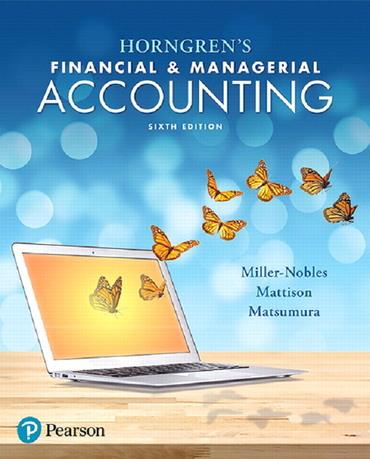Question
Theprocess-costing system at Fielding Company has a singledirect-cost category(direct materials) and a singleindirect-cost category(conversion costs). Direct materials are added at the beginning of the process.
Theprocess-costing system at Fielding Company has a singledirect-cost category(direct materials) and a singleindirect-cost category(conversion costs). Direct materials are added at the beginning of the process. Conversion costs are added evenly during the process. When the assembly department finishes work on each carseat, it is immediately transferred to testing. Fielding Company uses the FIFO method of process costing.
Physical Units
Direct
Conversion
(Car Seats)
Materials
Costs
Work inprocess, October1a
5,200
$1,432,600
$527,280
Started during October 2017
19,000
Completed during October 2017
21,500
Work inprocess, October31b
2,700
Total costs added during October 2017
$4,085,000
$2,028,000
aDegree ofcompletion: directmaterials, ?%; conversioncosts, 65%.
bDegree ofcompletion: directmaterials, ?%; conversioncosts, 80%.
Direct
Conversion
Materials
Costs
Costs incurred to date
$
5,517,600
$
2,555,280
Divide by equivalent units of work done to date
24,200
23,660
Cost per equivalent unit for work done to date
$
228
$
108
Total
Direct
Conversion
Production Costs
Materials
Costs
Completed and transferred out
$
7,224,000
$
4,902,000
$
2,322,000
Work in process, ending
848,880
615,600
233,280
Total costs accounted for
$
8,072,880
$
5,517,600
$
2,555,280
Requirement 1. For each costcategory, compute equivalent units in the assembly department. Show physical units in the first column of your schedule. (For amounts with a 0balance, make sure to enter"0" in the appropriatecell.)
Equivalent Units
Physical
Direct
Conversion
Flow of Production
Units
Materials
Costs
Work in process beginning
Started during current period
To account for
Completed and transferred out during current period:
From beginning work in process
Started and completed
Work in process, ending
Accounted for
Equivalent units of work done in current period only
Requirement 2. For each costcategory, summarize total assembly department costs for October 2017 and calculate the cost per equivalent unit.
Begin by summarizing the total costs to account for.
Total
Direct
Conversion
Production Costs
Materials
Costs
Total costs to account for
Next calculate cost per equivalent unit for direct materials and conversion costs.
Direct
Conversion
Materials
Costs
Divide by
Cost per equivalent unit for work done in current period
Requirement 3. Assign total costs to units completed and transferred out and to units in ending work in process.
Begin by calculating the total from beginninginventory, then calculate the total costs accounted for. (Abbreviation used; WIP= work in process. For amounts with a$0 balance, make sure to enter"0" in the appropriatecell.)
Total
Direct
Conversion
Production Costs
Materials
Costs
Completed and transferred out:
Total from beginning inventory
Total costs of units completed and transferred out
Total costs accounted for
Requirement 4. Explain any difference between the cost per equivalent unit in the assembly department under theweighted-average method and the FIFO method.
The cost per equivalent unit
differs
is the same
between the two methods because each method uses
different
the same
costs as the numerator of the calculation. The FIFO method uses
costs from the beginning work-in-process as well as costs added during the current period
only the beginning work-in-process costs
only the costs added during the current period
and theweighted-average method uses
costs from the beginning work-in-process as well as costs added during the current period.
only the beginning work-in-process costs.
only the costs added during the current period.
Both methods use
different
the same
equivalent units in the denominator.
Requirement 5. Should Fielding's managers choose theweighted-average method or the FIFOmethod? Explain briefly.
Begin by completing the table below that summarizes the costs assigned to units completed and those still in process under theweighted-average and FIFOprocess-costing methods.
Weighted-average
FIFO
Difference
Cost of units completed and transferred out
Work in process, ending
Total costs accounted for
Fielding's managers should consider the
FIFO
weighted-average
method because even though it shows
lower
higher
operating income and
lower
higher
cost of goodssold, it
lower
higher
taxes. Managers may have anincentive, however, to use the
FIFO
weighted-average
method and show higher income if themanagers' compensation increases with
lower
higher
operating income or if there are debt covenants that would be violated by showing
lower
higher
income. Another advantage of the FIFO method is that it provides better information for managing the business because it keeps
separate the costs of the current period from costs incurred in previous periods.
smootsh the cost per equivalent unit.
Step by Step Solution
There are 3 Steps involved in it
Step: 1

Get Instant Access to Expert-Tailored Solutions
See step-by-step solutions with expert insights and AI powered tools for academic success
Step: 2

Step: 3

Ace Your Homework with AI
Get the answers you need in no time with our AI-driven, step-by-step assistance
Get Started


